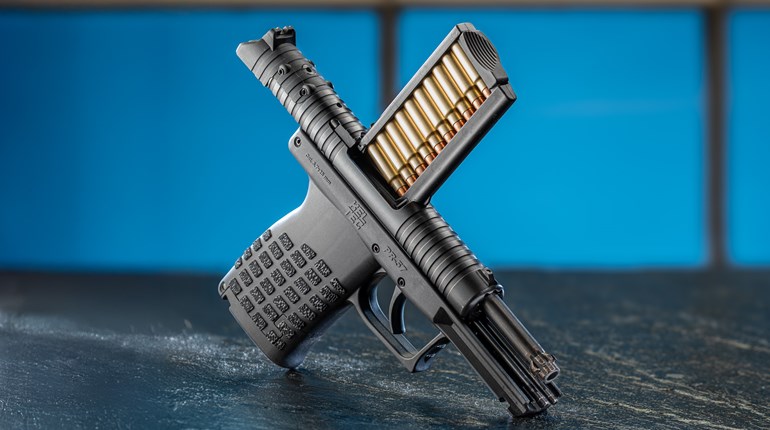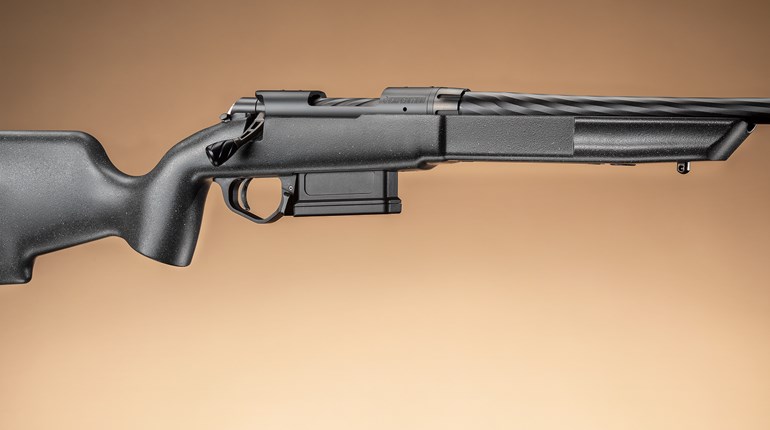
Exploiting your enemy’s weakness is good military strategy. That also holds true in the cutthroat marketplace that is the firearm business. What does your gun offer that the other guy’s doesn’t? Well, talk it up and make it seemingly the most important thing in the world. That’s been a dilemma for awhile now, but the new Taurus Spectrum pistol is about to take its shot.
Mighty or Mighty Ugly?
There are elephant guns and then there are “elephant-in-the-room” guns. Glock is the latter. We aren’t supposed to compare guns here in concrete terms, but conceptually, since its introduction, all tactical handguns have had to compete with Glock. Look at the market over the last 30 or so years. As I’ve noted before, handguns now fall into two broad categories, with a few exceptions: 1911s and polymer-frame, striker-fired pistols. Granted, there are a few “traditional” double-actions out there; the presence of their hammers now touted as a virtual novelty. Hell, even John Browning’s (and Dieudonné Saive’s) venerable double-stack—the Hi Power—has surrendered the stage to the Austrian gun and its ilk.
The reason this pistol has proven so problematic to the rest of the industry is that it offers very few weaknesses, if any, to exploit. Lightweight, durable, low maintenance, simple to operate, rust- and corrosion-resistant, ergonomic, accurate, supremely reliable and even affordable, it doesn’t seem to want for anything.

Well, OK, there is one thing: To most people, it’s butt ugly. I say that with love, as it is my primary fightin’ gun (though, blessedly, it’s never been put to the test) and the one I carry, given my druthers. But it’s hard to look at: Blocky, matte-finished, with that forever weird-looking blade safety and those graceless lines. I actually have a Smith & Wesson Performance Center Model 66 F-Comp that I carry on occasion just to cut the ugly of wearing the Glock everyday (also, as an added bonus, it pisses off our compatriots in the Education & Training Department).
One of the consumer benefits of the introduction of the Glock was that it forced everyone to step up their reliability game. No longer could manufacturers sell consumers a pistol expecting them to happily take it to a gunsmith for deburring, polishing the feed ramp, throating the barrel, etc. New pistols had to function correctly out of the box, or else. In the past couple decades we’ve seen pistol reliability improve to the point where it is now expected when you purchase a new product from a reputable manufacturer. And that presents an interesting question, one that Taurus appears to be posing with the Taurus Spectrum. Once Glock-like, 100-percent reliability has been achieved and an adequate standard of accuracy reached, can’t aesthetics have a seat at the table?

Taking Aim
Taurus has long beaten most every competitor out there on price point, but accuracy is always a tricky thing. How much is enough? While I agree with Sheriff Jim that you don’t want to assume a confrontation will be “average” and want the most accuracy possible, price is often the limiting factor. Tauruses aren’t known for accuracy and the argument of where to set the bar for its small carry guns has been problematic. Given the likely role of the Taurus Spectrum—a portable, concealable, ever-present defense against “typical” violent assaults or threats thereof—the accuracy bar is likely to be fairly low. However, as we’ll see, the Spectrum might just hurdle whatever reasonable bar may have been set for it.

What Price, Beauty?
OK, so a gun is absolutely reliable and exhibits decent accuracy. Why do aesthetics suddenly become so important? Because guns are consumer items, like most anything else (except they are referenced in the Constitution) and are subject to some of the very same influences that traditionally prompt buyers.
Some guns have what realtors call “curb appeal.” Without knowing any specifics, you just like how it looks and are drawn to it. “Pride of ownership” is a concept car dealers often rely on. You respond emotionally to your car, are proud to be seen in it and consider it a reflection of self. Among pistoleros, you’ll hear the term “barbecue gun.” That’s the gun you open-carry when hosting a barbecue for your friends. You’re not expecting trouble, you just wanna show off that bad boy to your buddies.

The Taurus Spectrum is a straight-from-the-factory barbecue gun. It’ll be available in a range of colors (the whole color “spectrum”) and you can order it any way you’d like it: with a stainless or Melonite-treated slide, a polymer frame of various hues and (most significantly) with accenting or contrasting synthetic overmolding. The strategically placed overmolding not only adds pleasing color, it greatly enhances manipulation-enabling purchase, something often lacking in polymer-frame pistols.
“Swoopy”—that’s how I’d describe the Spectrum’s looks. It is a collection of sleek, sinuous curves and soft angles that appears futuristic and looks comfortable. To borrow a description of some other “dehorned” pistols, it is as smooth as a well-used bar of soap (though not nearly so slippery).
The pistol sits deeply in the hand, thanks to the sculpted backstrap. The texture of the overmolding, while not aggressive, is effective and the material seems to dampen perceived recoil.
The Taurus Spectrum: Not Just a Pretty Face
Testing the Taurus Spectrum for accuracy was the least-appealing prospect of the gun. It was designed to be pleasingly sinuous, sure, but reliability and accuracy are where the rubber meets the road. If the stylish little pistol were accurate, it would gain serious traction with consumers.
My first efforts were frustrated by the sights and then by the trigger, both of which were something less than ideal, to be diplomatic about it. The small, integral black sights practically vanished against a large, black bullseye. I tried placing a small, quarter-size orange sticker in the center, but the sights still washed out against the black, such that I could not dot the “i” to form a sight picture. Finally, I flipped the bullseye over and stuck one of the little orange dots in the blank center of the back of the target. Aim small, miss small. I now had a sight picture.
The trigger is, to quote Charles Barkley, “terrble.” There is a very long, spongy take-up before it suddenly hits a wall that would make President Trump weep. The break measures a mere 8 pounds, 12 ounces, but—during aimed slow-fire from a rest—felt like twice that. There were moments I wondered if my finger would break before the trigger would.
That’s why it is with no mild shock that I report the Spectrum is quite accurate. It is a very difficult gun to shoot well, but once you learn its peculiarities, it’ll do its part. The more you shoot it, the better you learn where the trigger will break, allowing you to stage it with relative confidence. While you wouldn’t want to do so in a confrontation, knowing your gun is never a bad thing.

Second Impressions
In off-hand shooting, the wall of resistance present in the trigger will strongly make you dip the muzzle right before the break, causing the shot to go low and left (if you are right-handed). More than any other pistol I have handled, the Spectrum requires counter-pressure from the weak hand. And place that hand carefully, even when in a hurry, as it is easy to get the tip of your thumb in the vicinity of the muzzle if you are inattentive. If shooting one-handed, canting the Taurus Spectrum as much as 45 degrees inboard seems to minimize the muzzle dip the trigger causes.
The fingertip of the trigger finger can get rattled around pretty good inside the trigger guard during recoil. You may be better off using the first joint of your trigger finger rather than the pad of your fingertip. On the plus side, this pistol has virtually no muzzle rise. It’s back on target fast. Reliability was 100 percent, at least as far as going bang is concerned. Mid-test, the slide stopped locking back after the last round. All other functions were smooth and consistent, including the ejector, which threw cases clear with adequate (but not excessive) force.

The Taurus Spectrum comes with two magazines, a flush-fitting six-rounder, and an extended seven-round variant that features a finger groove for the pinky. For me, they largely determined how the Spectrum was carried. If I had a vest, jacket, untucked shirt or other covering garment, I’d insert the longer mag and wear the Spectrum in a belt holster. I’d have a quicker draw, more comfortable grip and greater firepower. If I wasn’t so attired, I’d slap in the flush-fitting magazine, slide the Spectrum into a pocket holster, then slip the combination into my front pants pocket. It is pretty versatile, easily adaptable to changing weather conditions or sartorial demands.
It would be less than honest not to acknowledge that, for a gun intended to be pretty, Taurus is starting off with perhaps the least-attractive iterations of the pistol. Go online to see snow-white-and-cyan Spectrums, teal-and-stainless Spectrums and black-and-coral Spectrums. What’d we get? All-black, and bronze metallic-and-gray. Seriously? Really—go online. There’s an interactive feature that allows you to scroll over the color options and see what your Spectrum will look like.
Taurus’ new gun is pretty and—surprisingly—that prettiness comes without cost. The Taurus Spectrum is small, light, concealable and ergonomic, remarkably accurate and, in our test, reliable (the slide lock issue notwithstanding). Being a Taurus, it’s also quite affordable. When it comes to what makes a pistol desirable, that’s pretty much the full spectrum.








































